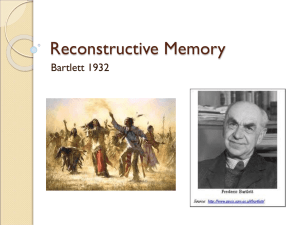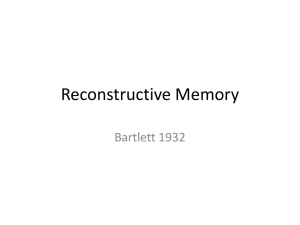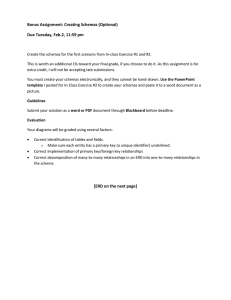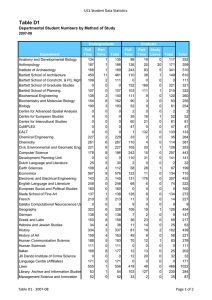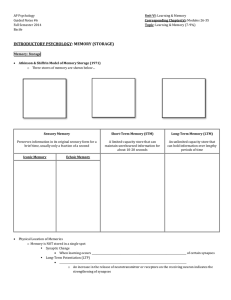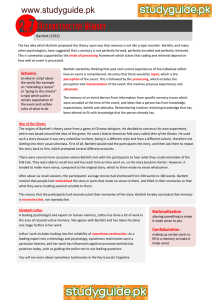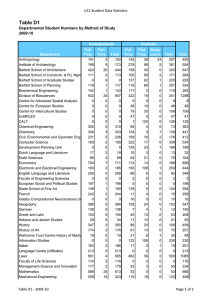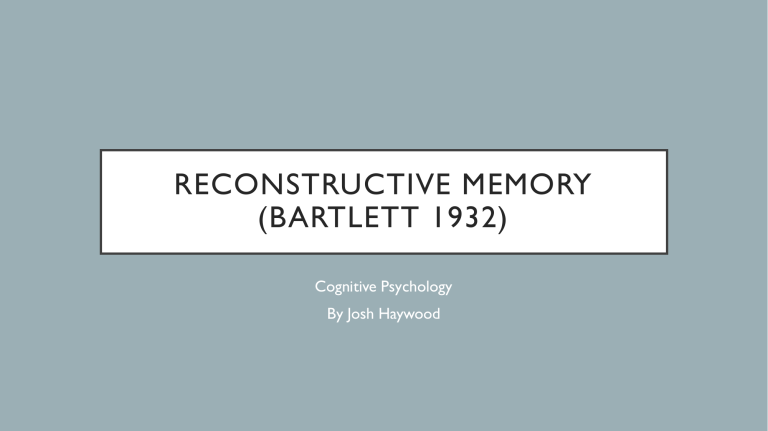
RECONSTRUCTIVE MEMORY (BARTLETT 1932) Cognitive Psychology By Josh Haywood STARTER ACTIVITY • Schema’s are shortcuts in our memory to make sense of the world around us • For example, when I went to shake your hand you extended your hand back as well as you know this from the schema about ‘greetings’. • Think of it like a filing system for your revision notes! • What Schema’s can you think of? • How many examples can you come up with? • You have 5 minutes! LEARNING OBJECTIVES • 1. All will be able to describe (AO1) Reconstructive Memory • 2. Most will be able to explain Reconstructive Memory • 3. A Few will be able to evaluate (AO3) Reconstructive Memory WHAT ARE SCHEMAS? • Bartlett’s main idea is that our memory is grouped into categories called “schemas”. • We have schemas for all sorts of thing – for what a “criminal” is like, for what counts as “food” • We can think of them as shortcuts ICELAND/GREENLAND BARTLETT’S SCHEMA’S 1 • Sometimes we assimilate new information, changing our schemas to fit what we have learned • Sometimes we accommodate new information, changing our memories to keep our schemas intact and unchanged. • Bartlett explains how we do this by levelling and sharpening. • Levelling involves removing or downplaying details from the memory and sharpening involves adding or exaggerating details. BARTLETT’S SCHEMAS 2 • Memory makes use of schemas to organise things. When we recall an event, our schemas tell us what is supposed to happen. • The schemas might fill in the gaps in our memory (confabulation) and even put pressure on our mind to remember things in a way that fits in with the schema, removing or changing details. For example, you might remember the Japanese diners eating with chopsticks (because that’s part of your schema for Japanese meals) whereas in reality the Japanese use their fingers to eat sushi and chopsticks for shashimi ACTIVITY • Someone in the class will now read out “The War of the Ghosts” • Listen closely and carefully! ACTIVITY • Now you must recall as much as the story as you can • You have 5 minutes! • Off you go! BARTLETT THE WAR OF THE GHOSTS (1932) • Bartlett showed 20 students a Native American ghost story (The War of the Ghosts) which had unusual features. • He asked them to read it then recall it on several occasions after a few hours, days, weeks or even years! – a technique called serial reproduction (and a Repeated Measures design). • Bartlett compared how the recalled versions of the story differed from the original. BARTLETT’S FINDINGS (1932) • Participants shortened the story when they reproduced it, from 330 words to 180 words. Participants also confabulated details, changing parts of the story to familiar ideas in line with their schemas: canoes and paddles became boats and oars, hunting seals became fishing. Participants rationalised the story, coming up with explanations for baffling parts of the story. For example, in later reproductions, participants missed out the “ghosts” and just described a battle between Native American tribes. FURTHER RESEARCH • Unfortunately, Bartlett’s research and ideas were ignored for many years due to his unscientific methods. • However, further research over the years developed and expanded on Bartlett’s theories and ideas. ACTIVITY • Half of the class will close there eyes (or place heads on the desk) looking away from the screen. • The other half will look at the image on the screen for a few seconds then describe the image to the classmate. ACTIVITY • Describe what you saw in as much detail as possible • The person who did not see the image will feedback to the class. ALLPORT & POSTMAN (1947) • Allport & Postman (1947) showed participants a drawing (below) of an argument on a subway train. • They were asked to describe it to another participant through serial reproduction (like Chinese Whispers). • The black character was better dressed and more respectable than the white character but, after serial reproduction, white participants tended to reverse their appearances. • Some even described the black character as holding a knife or gun! • Why do you think this happened? LOFTUS AND PALMER (1974) • Loftus & Palmer (1974) showed students film clips of real car crashes and set them a questionnaire to answer. • There was only one critical question which asked about the speed of the cars. Some students read a critical question with an intense verb (“How fast were the cars going when they smashed into each other?”) but others read a less intense verb like “hit”. • Participants exposed to the “smashed” verb recalled a higher speed (40.8mph on average) than participants exposed to “hit” (34mph). • Loftus & Palmer tested participants again a week later, asking them if there was any broken glass in the film clip. In fact there had been no broken glass. This was falsely recalled by 12% of the Control group (who had never been asked about the speed of the cars) and 14% of the “hit” group; however, 32% of the “smashed” group falsely recalled broken glass. LOFTUS AND PALMER (1974) • Loftus concludes that eyewitnesses are unreliable because they are influenced by leading questions. • When we reconstruct memories, we change them by incorporating new information we learned after the incident. • We also incorporate our schemas (expecting broken glass after a “smash” - this is sharpening the memory). • We cannot tell which parts of a memory are original and which parts are later changes and there’s no way of going back to the original. CODA (AO3) • In Edexcel Psychology, we use GRAVEC for Studies and CODA for theories. • Even though Bartlett used a study, the whole of reconstructive memory is a theory! • CODA stands for – • Credibility (How scientific is it?) • Objections (What issues are there?) • Differences/Different theories (How can other theories be used instead?) • Applications (How does this apply to society and psychology?) CREDIBILITY • Although Bartlett’s original study lacked credibility, The idea of schemas has been developed and supported in a lot of studies since the 1930s. • Elizabeth Loftus carried out a range of lab experiments into reconstructive memory, all of which had tight experimental controls, standardised procedures and collected quantitative data, making them quite objective and reliable. • Schemas also explains the puzzling phenomenon of false memories. In 2005, John Charles De Menezes was mistaken for a terrorist and shot by police after the 7/7 London Bombing. • Many eyewitnesses saw the shooting but their recollections were widely different and often exaggerated. Their schemas about the appearance and behaviour of terrorists might have sharpened and levelled their memories. OBJECTIONS • The early study by Bartlett was not at all scientific. Bartlett did not follow standardised procedures, getting his students to reproduce the story as-and-when. He had no scoring system for measuring changes in recall other than counting the number of words. This makes his research conclusions subjective. • Bartlett’s research was particularly unrealistic, getting Cambridge University students to recall Native American ghost stories. This strange task lacks ecological validity - although Bartlett claimed the task had to be strange so as to prompt the participants to level and sharpen the details in their memories. • The Allport & Postman (1947) study is widely misreported.You will see many Psychology text books and websites claiming this picture was shown to participants and that white participants wrongly recalled the black man as holding the knife. But this was not in the original study. This seems to be a case of ‘Chinese Whispers’ happening to psychologists! DIFFERENCES • Reconstructive Memory has links to Tulving’s theories about Semantic Memory. Tulving argues our memory has semantic stores where we keep our understanding of relationships and rules – very similar to schemas. • If Reconstructive Memory is true, this makes Tulving’s ideas more plausible. Moreover, semantic memory might have much more influence over episodic memory than Tulving imagined, because schemes dictate how we reconstruct our memories. • A criticism of Reconstructive Memory compared to the other theories is that it doesn’t explain how memory is reconstructed. The other cognitive theories of memory describe the processes at work in rehearsing, retrieving and recalling. • These processes have been linked to specific parts of the brain thanks to brain scanning and research on patients with lesions in specific parts of the brain. Reconstructive Memory is much more vague about how schemas work and where they are located. APPLIC ATIONS • The idea of schemas helps us understand some things about patients with memory loss like Clive Wearing or people in the early stages of dementia. Though they may be confused by their amnesia, they might still remember important schemas and this could be used to calm and focus them. • For example, Clive Wearing still loved his wife and loved music, which he could still play. Validation Therapy involves “going along” with delusional ideas so as not to cause distress when a patient’s schemas conflict with the real world. • Elizabeth Loftus is often called to US courts as an “expert witness” to advise juries about how much trust they should put in eyewitnesses. Loftus has been involved in a number of “recovered memory” cases where someone receiving psychotherapy starts to recall sexual abuse from their childhood that they had not known about before. Loftus argues these are “false memories” based on leading questions from therapists and schemas about child abuse in the media.
